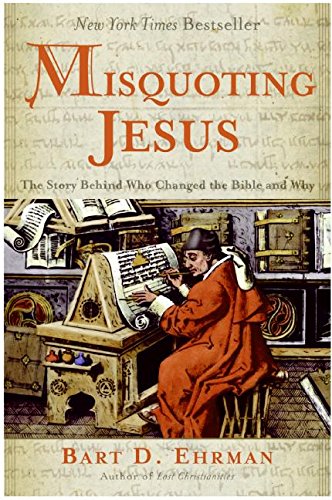The story behind who changed the Bible and Why
Bart D Erhman, Harper One, 2005

He states that the books purpose is to provide layman an insight into textual analysis, the aim of which is to find out what was first written and what was meant by it. A common claim is that the original scriptures were inspired. An often repeated phrase used by Ehrman in his video’s etc is “We don’t have the originals, we don’t have copies of the originals or copies of the copies of the copies of the originals. What we have are copies that are made much later, these copies differ from each other in thousands of places.” Ehrman suggests it would be no more difficult for God to preserve the words of scripture than it would have been for him to inspire them in the first place. Therefore, Ehrman reasons that if God was not prepared to perform a miracle to preserve these records, then there seems to be no reason to think he performed the earlier miracle of inspiring those words
From my own observation. I find Ehrman’s conclusion a compelling argument ‘For God is not the author of confusion’ 1 Cor 14:33. However Jesus (God of the Old Testament and Book of Mormon) surprisingly appears inconsistent on the subject of record keeping which runs counter to Heb 13:8 Jesus Christ is the same yesterday and today and forever.
The Ten commandments are inscribed onto stone tablets and housed in the arc of the covenant
In the Book of Mormon, the law of Moses was deemed so essential that The Lords Spirit declares, “It is better that one man should perish than that a nation should dwindle and perish in unbelief”. This law was contained on plates of brass.
Yet when the new covenant is revealed by Jesus in the meridian of time, it is among illiterate disciples, none are commanded to make a record, as a result confusion ensues.
Ehrman proposes that those who wrote the copies would naturally makes errors in transcribing but more importantly scribes were motivated to change the text to make them fit into what he terms ‘proto- orthodoxical’ views. The views that ‘won out’ in terms of doctrine. He illustrates how it is possible to uncover alterations to the copies, I cite one of his examples. Luke generally represents Jesus as never being perturbed in any way except in later manuscripts see 22:44 ‘And being in agony he began to pray….and his sweat became like drops of blood falling to the ground’. Scholars have debated whether this passage was inserted by a later scribe.
The manuscripts that are known to be the earliest and that are generally conceded to be the best (e.g. Alexandrian) do not as a rule include verses 43 & 44, the scholarly debate is more intricate than the basic premise I have used but I wish to highlight the potential reason for such a change. The Docetist view held that Jesus was not a full flesh and blood human, that he only seemed to be. A scribe aware of such a view in his day could counteract that claim by stating Jesus sweat like drops of blood.
I realise my precis is a simplistic account of one of Ehrman’s proposition’s which he only suggests as a possibility, but his book considers many other such examples. One of the reasons I enjoy reading anything published by Ehrman is his avoidance of ‘long words’ he tries to write in a style that includes non experts and if you ever listen to him speaking, the text reads like one of his engaging presentations.
Comments welcome contact info@mormonreflections.org.uk